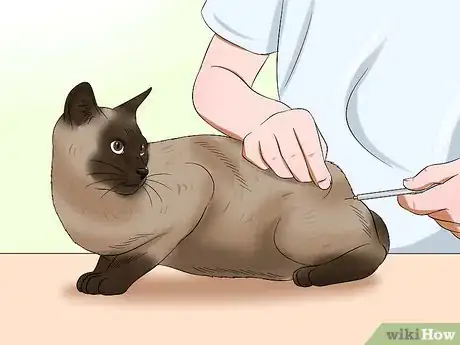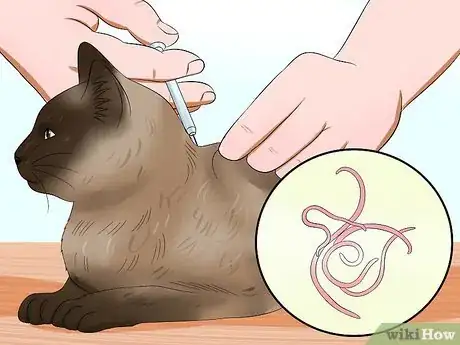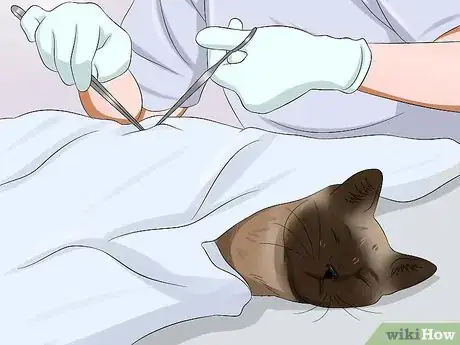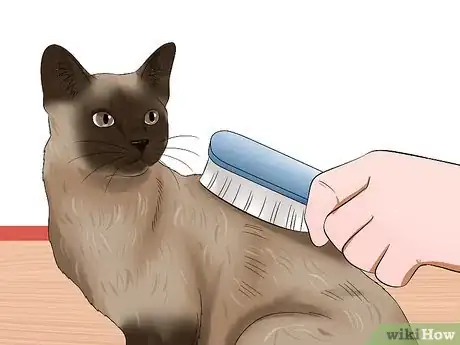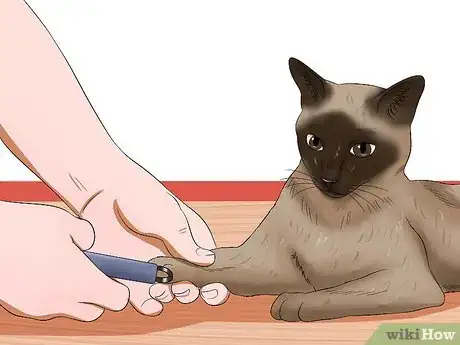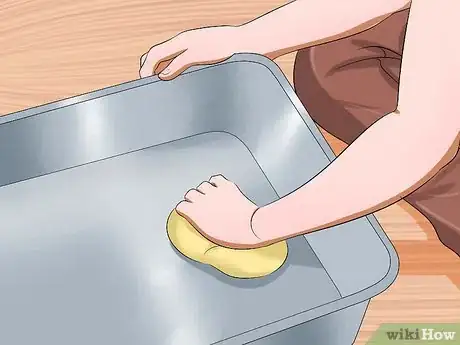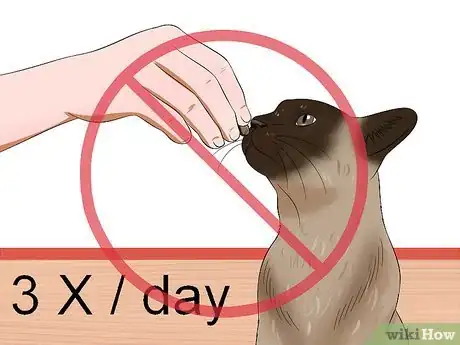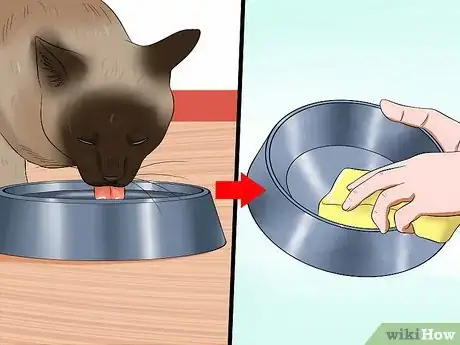This article was co-authored by Pippa Elliott, MRCVS. Dr. Elliott, BVMS, MRCVS is a veterinarian with over 30 years of experience in veterinary surgery and companion animal practice. She graduated from the University of Glasgow in 1987 with a degree in veterinary medicine and surgery. She has worked at the same animal clinic in her hometown for over 20 years.
There are 15 references cited in this article, which can be found at the bottom of the page.
This article has been viewed 15,603 times.
Burmese cats are stocky, muscular, and medium sized. Burmese kittens are known for being active explorers, though their adult counterparts tend to be more relaxed and lazy despite their love of playing.[1] If you want a Burmese cat, there are ways to ensure your loving and friendly cat lives a healthy, happy life.
Steps
Providing Proper Health Care
-
1Be aware of breed-specific issues. Burmese cats are generally healthy cats, but there are some issues that your cat is more prone to have. Burmese kittens can be born with congenital diseases, such as facial and head defects as well as heart problems.[2] Adult Burmese cats are more prone to obesity and diabetes.[3] This is why it is important to monitor her eating throughout her life, because obesity can lead to diabetes. As she ages, look for sign of diabetes, such as:
- Increased drinking
- Increased urination
- Inappropriate urination, such as in spots where she shouldn't
- In rare cases, an increase in appetite
-
2Get her vaccinated. When you first adopt your cat, she should be taken for a series of core vaccinations, including distemper, feline leukemia, and rabies as well as other common diseases. She will also need a feline leukemia test within the first few months. There are other vaccinations your cat can get, so check with your vet to see if there are other vaccinations that might be good for your cat. [4]
- If you got your cat from a breeder or shelter, check to see if they will give you her records to see if she had anything done before you adopted her.
Advertisement -
3Deworm your cat. Kittens should also be dewormed, starting as early as three weeks of age. She should then be dewormed a minimum of two more times. These visits should be three to four weeks apart.
- Your vet will do a fecal examination to ensure that your cat doesn't have any other parasites that need to be treated.
- If you get your cat from a shelter, it is very important for your to check her for worms and other parasites. These are spread easier in shelters.
-
4Spay or neuter your cat. If you don't plan to breed your Burmese cat, you should have her spayed (or neutered if male) by the time she is six months old. This procedure helps you prevent unwanted kittens and prevents problems with other cats.
- It also helps prevent certain cancers and diseases, such as urinary tract infections and genital based cancers.[5]
-
5Get regular check ups. You cat should have regular check ups at the vet. Around one year old, your cat should have her vaccinations updated if necessary. As she ages, she needs to go periodically for general health checks.[6]
- When she turns 10, she should go to the vet twice a year for health checkups to make sure she stays healthy. It will also help you catch age specific diseases early.
Taking Care of Your Burmese Cat
-
1Exercise your cat. To keep you keep you Burmese cat's muscles in shape and help keep her mind active, you need to exercise her daily. You should play interactive games with your cat to help you bond with her and give her the stimulation she needs. Try using laser lights, feather toys, and fake mice. Have her chase the laser lights around the room, chase the feather toys as you dangle them around, or fetch them across the room.
- Avoid giving her string or rubber bands she could accidentally eat. Ingestion of these things can cause serious problems.
- You should also get her a scratching post to help exercise her toes and feet. This will help keep her claws away from your furniture and fabrics around your house.
- This is also a great way for your cat to remove the dead outer claw material from her paws and allows her to mark her territory.[7]
- Think about buying her a cat tower, which gives her places to scratch as well as places to jump, play, and exercise.
-
2Keep your cat's fur short. Burmese cats have short, silky hair and it typically needs very little grooming. About once a week, brush your cat to help get rid of stray hairs and cut down on how much she sheds.
- This will also give you time to bond with your cat each week.[8]
- You should also use this time to check for skin issues and fleas. As you brush, look for lumps, bumps, patches of red skin, or sores.
- If you find fleas, buy topical flea treatment and flea shampoo to fight the fleas. If you find a skin issue, keep a watch on them for the next few days. If they grow, get worse, or become infected, contact your vet.
-
3Trim her nails. Your Burmese cat's claws need to be taken care of every so often. You can use human nail clippers or those specifically made for a cat. Look at the claws and clip the white tips off the nails. Avoid the pink area of the nails because these hold the nerves and blood supply for the nails.[9]
- To position your cat for nail clipping, settle the cat in your lap and lay your non-dominant forearm gently but firmly on her upper body so she can't squirm or scratch you. Pick up the paw with your non-dominant hand and gently press on it to make the nails come out. Then trim each paw this way. [10]
-
4Brush her teeth regularly. To keep your Burmese cat as healthy as possible, you should brush her teeth regularly, which is about once a week. Find a soft bristled toothbrush and cat toothpaste, which you can get from your vet or at most pet stores.
- Start off small with your kitten, letting her taste the toothpaste before you use it. Then use it along her gums the next day, graduating to brushing her teeth the next day with the toothbrush in small, gentle circles. It should take about a minute to do her whole mouth.
- It may take a few days for her to allow you to brush all her teeth, but just keep at it. She will get used to it the more you do it.
- Never use human toothpaste because fluoride is poisonous to cats.[11]
-
5Keep her little box clean. You should keep your cat's litter box clean so she has a clean place to go to the bathroom every day. Cats prefer clean, soft litter, so basic commercial clumping litter is just fine for your pet. [12]
- It is possible for your cat to develop a preference for other kinds of litter. If your cat is used to a different kind of little from before you adopted her, she may require different kinds, such as clay like litter.
Feeding Your Cat
-
1Buy high quality food. Burmese cats need certain types of nutrients in order to avoid certain health issues, such as eye conditions and heart disease. Make sure your cat food has plenty of natural meat sources and is not made with just meat byproducts. Look on the label at the ingredients and avoid any food that lists meat byproducts or grains as the first few ingredients.
- Your cat is a natural carnivore, which means she requires certain amino acids found in meat products. If your cat doesn't get enough of them, her health will suffer.[13]
- If you aren't sure which food is right for your Burmese cat, ask you vet for advice.
-
2Feed her the right amount. Your Burmese cat is prone to obesity as she grows older because she will become lazier as she ages. Because of this, you need to make sure you feed your cat the suggested amounts of cat food each day. Look on the label of your cat food to find out how much food you need to feed her every day.
-
3Avoid too many treats. Sometimes, you may be tempted to feed your cat a lot of treats throughout the day. This can add extra weight to your cat over time as well as mess up the balance of her nutrients. You should not feed treats to your cat more than once or twice a day.
- Don't give milk to your cat as a treat. Cats have a hard time processing the lactose in milk, so feeding them too much of it can cause diarrhea or vomiting.[16]
-
4Provide fresh water daily. In order to keep your cat healthy, she needs to have access to fresh water every day. You can even have them in multiple places throughout the house so she is encouraged to drink more each day.[17]
- Change the water bowls daily to avoid the build-up of algae or other bacteria.
References
- ↑ http://www.hillspet.com/cat-breeds/burmese.html
- ↑ http://www.petinsurance.com/healthzone/pet-articles/pet-breeds/Burmese-Cats.aspx
- ↑ http://icatcare.org/advice/cat-breeds/burmese
- ↑ https://www.aspca.org/pet-care/general-pet-care/vaccinations-your-pet
- ↑ https://www.aspca.org/pet-care/general-pet-care/spayneuter-your-pet
- ↑ https://www.aspca.org/pet-care/cat-care/general-cat-care
- ↑ http://www.humanesociety.org/animals/cats/tips/destructive_scratching.html
- ↑ http://cfa.org/Breeds/BreedsAB/Burmese.aspx
- ↑ http://www.vetmed.wsu.edu/ClientED/cat_claws.aspx
- ↑ https://www.aspca.org/pet-care/cat-care/cat-grooming-tips
- ↑ https://www.aspca.org/pet-care/cat-care/cat-grooming-tips
- ↑ http://www.humanesociety.org/animals/cats/tips/preventing_litter_box_problems.html?referrer
- ↑ http://www.aspca.org/pet-care/cat-care/cat-nutrition-tips
- ↑ The Evolutionary Basis for the Feeding Behavior of Domestic Dogs (Canis familiaris) and Cats (Felis catus) John W.S. Bradshaw The Journal of Nutrition. July 2006 vol. 136 no. 7 1927S-1931S
- ↑ https://www.aspca.org/pet-care/cat-care/cat-nutrition-tips
- ↑ https://www.aspca.org/pet-care/cat-care/cat-nutrition-tips
- ↑ https://www.aspca.org/pet-care/cat-care/cat-nutrition-tips
About This Article
To care for a Burmese cat, make sure you give it high-quality food with enough natural meat so that it can avoid health issues like eye and heart conditions. Since Burmese cats are prone to obesity, only give your cat the recommended amount of food each day, spread out over two to three meals, and treats no more than twice a day. Burmese cats are also more likely to develop diabetes, so keep an eye out for symptoms of the disease, including increased drinking and urination. If you notice any of these, consult a vet for their recommendations. For more advice from our Veterinary co-author, including how to trim your Burmese cat’s nails, read on!

